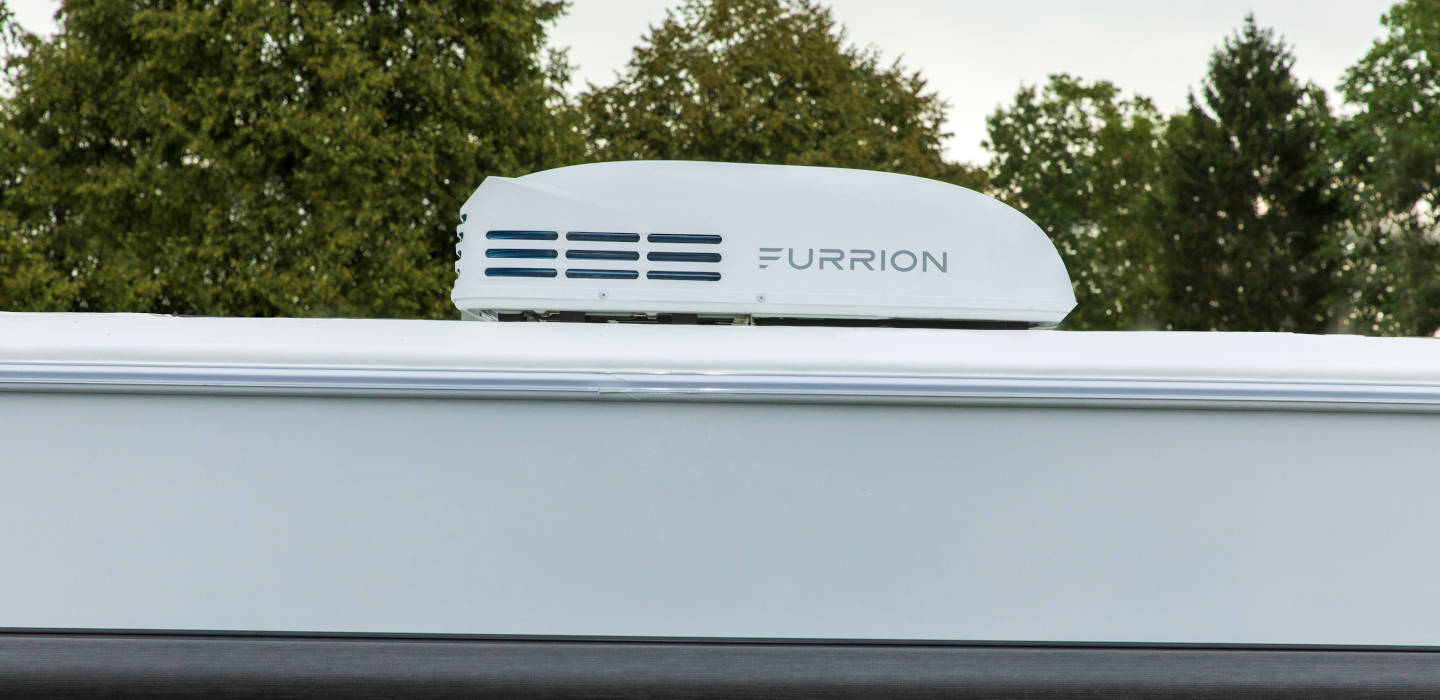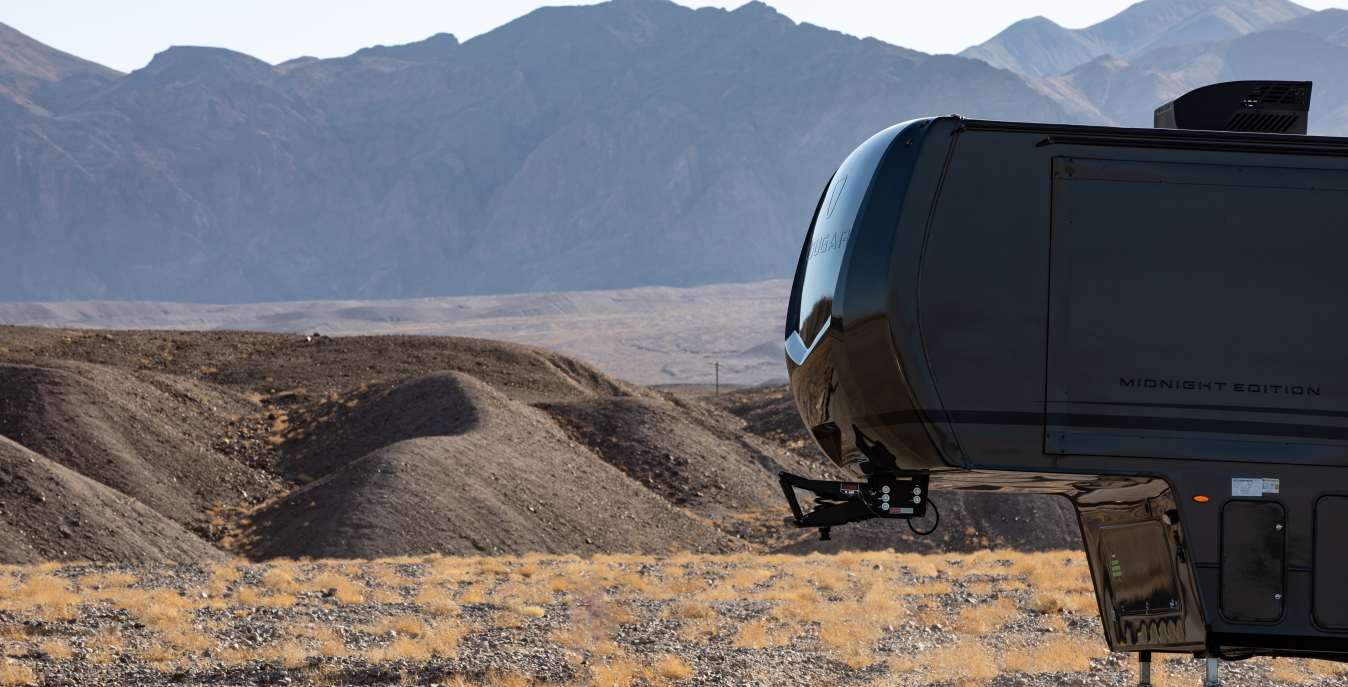Keeping your RV cool and comfortable on the road starts with having the right air conditioning system. While most RVers recognize the importance of a reliable rooftop unit, fewer understand how the air is delivered inside the coach and how that delivery method impacts comfort, noise, installation, and cost.
In this guide, we’ll explore the differences between ducted and non-ducted RV air conditioners, break down their advantages and drawbacks, and help you understand how each is tailored for specific RV applications.
What You’ll Learn:
- The fundamental distinction between ducted and non-ducted systems
- How each system works, from rooftop unit to cabin vents
- Pros and cons of ducted vs. non-ducted setups
- Key factors to consider, like RV size, layout, and power sources
- How Furrion’s versatile AC lineup fits both configurations
Fundamental Differences between Ducted & Non-Ducted RV ACs
At its simplest, a ducted system moves air from the rooftop unit through a network of hidden ceiling ducts and out vents in multiple locations. A non-ducted setup sends cooled air directly from a single interior box (the air distribution box or ADB) into the RV.
Both methods use the same core components — a compressor, evaporator and condenser coils, refrigerant, and fans — but differ in how they disperse air.
How Ducted Systems Work
When you have a ducted RV air conditioner, you have a system that channels cool air through a hidden network of wall or ceiling ducts. Instead of feeling a blast of cold air from a single point, you enjoy a gentle, consistent airflow delivered through multiple vents throughout your coach.
Ducted setups are prized by RVers who want that residential-style comfort and whisper-quiet operation, especially in larger rigs with separate living and sleeping areas.
Here's the step-by-step process:
-
The Thermostat Initiates Cooling
When your central controller senses the cabin’s temperature rising above your set point, it signals the rooftop unit. There's not much difference here between ducted and non-ducted except that in non-ducted setups, the air distribution box itself often contains the control interface. -
The Rooftop Unit Cools the Refrigerant
Both ducted and non-ducted systems rely on the compressor and condenser to cool refrigerant. Again, there is very little difference between the two types of systems here. -
Air Gets Pushed into the Ceiling Ducts
This is where ducted is completely different than ductless. In a ducted system, a dedicated blower forces chilled air into ductwork that courses throughout the RV, cooling the various zones or spaces from multiple channels. In non-ducted units, air is blown air directly through a single louvered vent in the ceiling. -
Multiple Vents Deliver Even Airflow throughout the RV
Because air travels through a network of vents in each zone (living area, bedroom, kitchen), ducted systems offer balanced, whisper-quiet distribution, cooling these rooms more efficiently and effectively.
Learn more about how RV ACs operate

How Non-Ducted Systems Work
A non-ducted — or ductless — RV AC keeps things simpler by blowing cooled air directly into the cabin through an air distribution box mounted in the ceiling. There’s no hidden ductwork behind your walls or ceiling. The rooftop unit houses the evaporator, fan, and controls. This setup is ideal for smaller or open-plan RVs, where quick installation, easy filter access, and targeted airflow trump multi-zone finesse.

Ducted vs. Non-Ducted: Pros & Cons
The difference between ducted and non-ducted RV AC systems isn’t just about price or installation. It’s about how that system will perform day-to-day in your rig. In the table below, we’ve broken down the major advantages and drawbacks of each approach.
| Features | Ducted Systems | Non-Ducted Systems |
| Air Distribution | Even across multiple vents | Strongest near the ADB |
| Noise Level | Quieter inside (fans isolated on roof) | Louder (fan and compressor closer to you) |
| Installation | Complex — requires ceiling ductwork | Simple — single, direct opening in the ceiling |
| Maintenance | Duct cleaning is tougher; filter changes less frequent | Easy filter access; no duct cleaning |
| Multi-Zone Ready | Excellent — each zone gets its own duct and control | Requires multiple rooftop units for multi-zone |
| Aesthetics | Clean, flush vents; hidden ducts | ADB visible in the cabin |
| Cost | Higher initial install and labor | Lower equipment and installation cost |

Key Factors that Determine Ducted vs. Non-Ducted
Beyond basic pros and cons, several real-world considerations determine whether a ducted or non-ducted system is right. From how the RV is laid out to the climates you visit, and even the power sources you rely on, these key factors determine which AC setup makes the most sense for the RV.
1. RV Size & Layout
Your rig’s length and floorplan are the first considerations in determining whether it has a ducted or non-ducted system. In smaller RVs — typically under 25–30 feet long — with open, studio-style layouts, a non-ducted unit often provides more than enough coverage, since one centrally mounted air distribution box can reach every corner.
In contrast, larger 5th wheels, class A motorhomes, or trailers with distinct sleeping, living, and kitchen areas benefit from ducted airflow. By routing cooled air through hidden ceiling ducts to multiple vents, a ducted system maintains uniform temperatures across separate zones that a single-point blower might struggle to reach.
In summary:
- Under 25 feet: Non-ducted typically suffices
- 25–30 feet: Either option, based on how many rooms / partitions there are
- 30+ feet: Ducted systems are ideal for multi-room comfort

2. Travel & Climate
Where you go and how long you stay on the road can also play a role. If you're shopping for an RV and you're planning to frequently boondock in mild climates or enjoy three-season camping in temperate regions, an RV with a simpler non-ducted setup may suffice, and it will be easier to power via small generators or solar arrays.
But for extended stays in extreme heat or high-humidity areas (think southern deserts or Gulf Coast summers), the even distribution and quieter operation of a ducted system can be a game-changer. Ducted airflow helps prevent “hot spots” in larger RVs and can reduce run-times, improving comfort when ambient temps push your AC to its limits.
In summary, long stays in extreme heat favor ducted (more even cooling). Occasional use or moderate climates can make non-ducted more cost-effective.
3. Budget & Installation
Upfront and ongoing costs are inevitable parts of any RV decision. RVs with non-ducted systems generally have lower equipment prices and drop-in replacements — better for owners on a tight budget. Ducted systems, on the other hand, require ceiling ductwork installation and additional vents, increasing labor hours and material costs and contributing to the overall price of the RV. In other words, RVs with non-ducted systems are generally less expensive than RVs with ducted systems.
If you’re building a new custom coach or doing a full interior renovation, integrating a ducted setup can be worth the investment. But for quick turnarounds or modest upgrades, non-ducted installs keep both costs and complexity down.
In most cases, you'll be purchasing an RV with an AC system already installed. Keep in mind that the upfront cost will tend to be higher for an RV with a ducted system. If you're in a situation in which you need to replace an existing AC unit, Furrion offers flexible options for both ducted and non-ducted setups.

When to Choose Ducted over Non-Ducted
For RVs that stretch beyond 30 feet and feature distinct living areas — such as separate bedrooms, a kitchen, and a lounge — a ducted air conditioner is often the right choice. Its concealed duct network delivers gentle, evenly distributed cooling that mimics the feel of a residential HVAC system, eliminating cold spots and reducing fan noise in the cabin.
When to Choose Non-Ducted
For smaller RVs — typically under 30 feet long — with open-plan layouts, a non-ducted air conditioner offers a straightforward, cost-effective solution. Because the air distribution box (ADB) mounts directly to the ceiling and blows air straight into the cabin, installation is fast and doesn’t require hidden ducts or ceiling modifications. You’ll also appreciate the easy access to filters and controls for routine cleaning and maintenance.
Stick with What You Got
Oftentimes, the choice between ducted and non-ducted isn't really much of a choice at all. There are other factors at play that, in many ways, make the decision for you. For most RVs, you're not starting with a blank slate that allows you to choose one option or the other — unless you're building a custom RV from scratch!
More often than not, you'll be presented with two options: you'll either be purchasing an RV with an AC system already installed or you'll be replacing an existing AC system. In the first scenario, it's helpful to know the differences between ducted and non-ducted to choose the right model to suit your needs. However, usually the RV will have one system or the other based on its size, layout, and other factors. The system will be chosen for you to best suit the type of RV you're buying.
In the second scenario — that is, replacing an existing AC unit — the key is to identify which type of system you already have and to purchase the same type to replace it. If you have a ducted system, buy another ducted unit to replace it. If you have a non-ducted system, buy a replacement non-ducted unit. Be sure to consider BTU output, dimensions, and other key considerations, but in general, you won't need to worry about upgrading or converting to the other type of system.
Modern AC platforms — like Furrion’s Chill® Cube — offer options for both setups, so you can get a quality replacement no matter which system your RV has.
Furrion’s Flexible RV Air Conditioners
Furrion’s Chill® series ACs are engineered with the knowledge that both systems exist. We offer options for non-ducted and ducted units alike. This gives you the freedom to upgrade your RV AC no matter which system your rig has.
Our innovative Chill Cube rooftop unit is likewise available for ducted systems and non-ducted systems. It features a variable-speed compressor for quieter operation and improved efficiency, along with digital controls that integrate seamlessly whether you’re running through ceiling ducts or blasting air from a central louver.
Disclaimer: These photographs, recommendations, and approximations are intended for demonstration purposes only and do not reflect the specifications of any particular tow vehicle, recreational vehicle, or trailer. Always consult the manufacturer’s Owner's Manual.




What is an RV Air Conditioner? A Complete Beginner's Guide
Tired of Backup Camera Delay? Here’s How Vision S+ Solves the Problem.